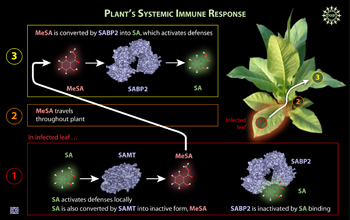Multimedia Gallery
The illustration depicts steps involved in the development of a systemic immune response in plants.
When a plant is infected by a pathogen, a plant hormone called salicylic acid (SA) activates defenses locally. Some of this SA is converted by an enzyme known as SAMT into an aspirin-like compound called methyl salicylate (MeSA) that travels to uninfected parts of the plant and thereby activates a plant-wide immune response. But some SA at the infection site binds to an enzyme called salicylic acid binding protein 2 (SABP2). This binding prevents the enzyme from converting SA at the infection site into biologically inactive MeSA.
Credit: Zina Deretsky, National Science Foundation
Images credited to the National Science Foundation, a federal agency, are in the public domain. The images were created by employees of the United States Government as part of their official duties or prepared by contractors as "works for hire" for NSF. You may freely use NSF-credited images and, at your discretion, credit NSF with a "Courtesy: National Science Foundation" notation.
Additional information about general usage can be found in Conditions.
Also Available:
Download the high-resolution JPG version of the image. (840 KB)
Use your mouse to right-click (Mac users may need to Ctrl-click) the link above and choose the option that will save the file or target to your computer.
Related story: Scientists to Sick Plants: Take Two Doses of an Aspirin-Like Hormone and Call Me in the Morning



